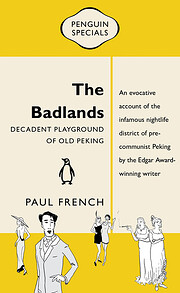

Auf ein Miniaturbild klicken, um zu Google Books zu gelangen.
|
Lädt ... The Badlands : decadent playground of Old Peking (2012. Auflage)von Paul French
Werk-InformationenThe Badlands: Decadent Playground of Old Peking von Paul French
 Keine Keine aktuelle Diskussion zu diesem Buch. keine Rezensionen | Rezension hinzufügen
Gehört zu Verlagsreihen
An evocative account by Paul French, author of the acclaimed Midnight in Peking, of the infamous nightlife district of pre-communist Beijing. Through portraits of eight White Russians, Americans and Europeans who lived and worked in the Badlands in the 1920s and '30s, Paul French brings the area and its era vividly to life. A small warren of narrow hutongs, the Badlands sat just inside the eastern flank of the Tartar Wall, which at that time enclosed the old Imperial City of Peking. Its habitués were a mix of the good, the bad and the poor unfortunates, among them the fiery brothel madams Brana Shazker and Rosie Gerbert; the pimp Saxsen, who had no regard for the women he exploited; the young prostitutes Marie and Peggy, whose dreadful working lives drove them into separate pits of madness and addiction. There was the cabaret dancer Tatiana Korovina, a White Russian girl who did not succumb to the vice of the district but instead married, had a family, and eventually left China to lead a long and happy life. There was the American Joe Knauf, who dealt violence and fear as well as drugs, and finally the enigmatic Shura Giraldi, of indeterminate sex, who was to some a charmer and to others a master criminal, but to everyone the uncrowned King of the Badlands. In depicting this colourful cast of characters, Paul French was assisted by readers of the extraordinary Midnight in Peking, who contacted him from around the globe. As the family and acquaintances of people he'd written about in that book, they had stories and recollections to add to French's own research. The result is a short but potent account of a time and a place until now largely forgotten, but here rendered unforgettable. Keine Bibliotheksbeschreibungen gefunden. |
Aktuelle DiskussionenKeineBeliebte Umschlagbilder
 Google Books — Lädt ... Google Books — Lädt ...GenresMelvil Decimal System (DDC)951.15604History and Geography Asia China and region Northeast China Hebei, Tianjin, Beijing BeijingBewertungDurchschnitt: (3.63) (3.63)
Bist das du?Werde ein LibraryThing-Autor. |
||||||||||||||||||||||||||||||||||||||||||||||||||||||||||||||||||||||||||||||||||||||||||||||||||||||||||||||||||||||||||||||||||||||
The latest clan of Chinese rulers is not very different. In as far as cultural objects were not outright destroyed, the new rulers have shown their disdain for both imperial art and the cultural heritage of imperialist intruders through neglect. Thus, for decades the former imperial palace, known to foreigners as the Forbidden City, was not much more than a compound within which citizens of the New China could gawk at the splendors of imperial decadence, while its woodwork rotted away, art was improperly stored and repair or restoration was clumsy.
Chinese people tend to view the historical interaction between the Chinese and foreigners merely as undesired intrusion by imperialist powers attempting to colonize China, or belonging to missionary efforts. Cultural and linguistic barriers hinder cultural dialogue, which remains limited because the Chinese view Chinese culture as superior to Western culture, for which they have thus little interest. On the other hand, it must be said that the volume of translated Western literature and the availability of, for instance, Western classical music in China surpasses the Western interest in Chinese culture by a very large margin, proportionally as well as in absolute terms.
Related to the idea that art and culture exist in the mind, more than in reality, in China has led to a greater focus on ideas and less on materialism. As a part of that, authenticity is also less important, and there seems to be a tendency to put the whole, overall picture, however inaccurate in parts, over the details. Thus, the preservation of cultural heritage in China is fundamentally different from the approach in the West, which tends to focus on analysis, meticulous description, restoration and preservation of authentic artefacts and monuments.
Besides these differences in dealing with historical artefacts and monuments, Chinese people are also more selective in what to preserve. Hence, Chinese historians do not only treat the cultural heritage of imperialist powers into China with disdain, they deliberately neglect the morally inferior sides of that Western culture, such as the decadence of foreign culture in brothels and opium dens near the Legation Quarter in Beijing.
Paul French small publication The badlands. Decadent playground of Old Peking tries to fill up that void.
In The badlands. Decadent playground of Old Peking, Paul French describes the history of a section of Peking located just to the east of the Legation Quarter, within the Tartar City. The year is 1937.
Paul French has done the admirable job of tracking down eye witnesses who have been able to tell him, and even supply photographs of the "Red Light District" of pre-revolutionary Peking. In this part of the historical centre of Beijing, several opium dens and Houses of Sing-Song girls were located within walking distance from the Foreign Embassies. But the foreigners who lived in this quarter were among the poorest of the poor, suffering from an alcohol or opium addiction. They would earn their money with song and dance or gambling.
The badlands. Decadent playground of Old Peking is a small monograph of a part of history which, it seems, the Chinese would rather prefer to forget or blot out. The paucity of source materials can be clearly felt, but Paul French has an engaging style of writing which tells the reader about life on the volcano, just before the Japanese invasion of Beijing which would tumble China into the Second World War and subsequent Civil War which for one and all closed that chapter of foreign history in China. (